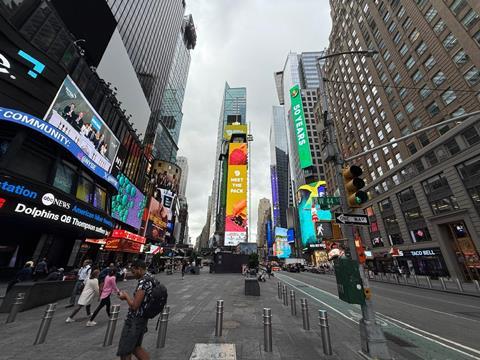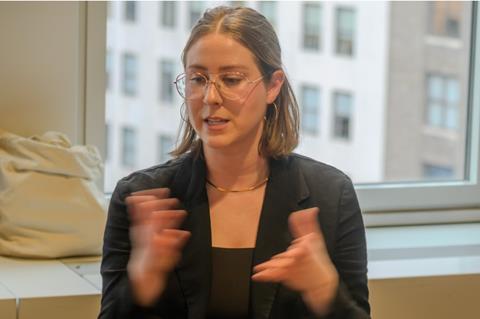As part of last month’s Climate Week NYC, Building hosted a roundtable with the support of Gleeds and in partnership with the Climate Group. Our discussion with leading construction experts identified the blockers to greener buildings and key drivers for change


New York during September’s Climate Week is the place to be for committed professionals keen to share solutions in a common effort to take action and address the climate crisis.
With so many sessions happening each day, the Building team selected some key built environment topics to highlight to our readers – and we went one step further: we hosted our own roundtable in association with the Climate Group and supported by Gleeds.
At a venue on Broadway, minutes from Times Square, Building’s editorial director Chloë McCulloch chaired a discussion with 13 construction professionals from around the world with different areas of expertise.
Over an hour and a half, they debated the dual pressures to decarbonise the built environment that are coming from investor demand and regulatory change. Clearly both are important drivers in decarbonising our built assets – and they are inextricably linked.
As was pointed out early in the discussion, the relationship between funding and regulations is symbiotic: investors react to policy-makers’ regulations and in turn policy-makers develop regulations with an eye to what the market can absorb.
People also felt that the balance of pressure from investors or regulations depended on the asset type they are working on and where they operate globally, whether that is on projects in the UK, the US, Europe or the global south.

This wide-ranging and detailed discussion threw up some challenging points, and the panel were frank about the sticking points and hurdles that exist for project teams in delivering greener buildings and infrastructure.
>> Also read: Highlights from New York’s Climate Week
While everyone was keen to take responsibility for doing their bit and advocating for low carbon solutions, the reality often is that consultants, architects and contractors are not the ultimate decision-makers. The landscape set by regulators, investors and clients determines so much of what is built or refurbished, and influencing both can be an uphill task.
Here is a summary of our panel’s views on the topic.
Around the table

- Chair: Chloë McCulloch, editorial director, Assemble Media Group
- David Briefel, sustainability director and principal, Gensler
- Jen Carson, head of industry, Climate Group
- Adrian Farren, vice president for the Americas, Gleeds
- Irene Garcia, built environment lead, Carbon Neutral Cities Alliance
- Priya Jain, president for the Americas, Mace
- Paul King, chief executive, Built by Nature
- Julie Kjestrup, head of policy and thought leadership, Velux
- Anica Landreneau, global sustainable design director, HOK
- Maurice Loosschilder, global head of sustainability, Signify
- Kara Magoolaghan, principal, KMCG
- Mark McKenna, global sustainability director, Arcadis
- Michelle Regent, chief ESG officer, Gleeds
- Sigal Shemesh, sustainability lead, Skidmore, Owings & Merrill
The regulatory backdrop
Regulations vary hugely between countries and in the case of the US, where our roundtable was located, between states.
Michelle Regent, chief ESG officer at Gleeds, made this point, observing that the regulatory framework in the US appears to be more fragmented than in Europe. However, while the EU may have managed to create more of a uniform approach, the regulations there are still complex to navigate.
Many of the environmental impact reporting requirements for corporates have undoubtedly led to progress. Businesses in the EU are now, however, dealing with a growing level of complexity in the reporting process as a plethora of frameworks have emerged.

By way of example, Regent pointed to the workload and deadlines associated with the CDP, formerly known as the Carbon Disclosure Project – which is requested by global investors – alongside the reporting to comply with the EU’s Corporate Sustainability Reporting Directive (CSRD) which came into force in 2023. She said: “Yes, they are supposed to integrate and you are starting to see the links between them, but the demand and the scale of the questions asked is so vast – especially when you are working globally.”
The greater structure, the greater governance and the whole direction of travel of the EU taxonomy is positive.
Michelle Regent, Gleeds
She added: “The greater structure, the greater governance and the whole direction of travel of the EU taxonomy is positive. But impact reporting is very demanding on organisations, and I have had some interesting conversations with US [professionals] this week saying ‘maybe there are some lessons here, maybe we can leapfrog some of the complexity’.”
Other panellists could also see the pressure that is being felt right now to quantify impact when it comes to projects in Europe. Mark McKenna, global sustainability director at Arcadis, puts it down to the CSRD, particularly the new framework that introduced the principle of “double materiality” for assessing ESG impacts. This means that companies now have to report on not only how their business is financially impacted by climate change (financial materiality) but also their impact on people and the environment (impact materiality).
Another piece of EU regulation raised was the Revised Energy Performance of Buildings Directive, which came into force in May 2024 and which Julie Kjestrup, head of policy and thought leadership at Velux, said shows how a holistic approach can turn the dial. “For the first time, you have a piece [of legislation] around resilience and you have a piece around embodied carbon. It’s a piece of legislation that does combine that.”

Meanwhile Anica Landreneau, global sustainable design director at HOK, described the existing US regulations as “piecemeal”. The need for US regulations to move towards a total carbon measurement for buildings – so, not just operating carbon but also embodied carbon – was identified by both Landreneau and David Briefel, sustainability director and principal at Gensler. They agreed that when project teams are required to consider both “it really changes the calculation, and it does push you more towards looking at existing buildings repurposing or bio-based materials”.
Also looking at events through a US lens, Adrian Farren, Gleeds’ vice president for the Americas, highlighted the New York-specific Local Law 97 which came into force this year setting at target of 40% emission cuts in existing buildings by 2030, which he said could result in building owners being charged “a significant amount of money”. That prospect has led to a real shift in the last few years, though some on the panel disagreed about the effectiveness of the measures (see New York’s Local Law 97, below).
Regulating for operational and embodied carbon
Specific regulations may vary by country, region or state, but all the panel’s statements made clear that across the board a step-change is needed if there is any chance of hitting global carbon goals – particularly from an embodied carbon perspective.
Their experience on projects so far is that most action on embodied carbon has been driven by the values of individual firms, clients or industry initiatives rather than a uniform or mandated approach.

Paul King, chief executive of Built by Nature, felt strongly that the embodied carbon in building materials has been overlooked for too long and is in dire need of being regulated. His organisation focuses on increasing the use of sustainably sourced timber and bio-based materials as a complement to or replacement for more carbon intensive materials.
Before his current role, he explained he worked for main contractor and developer Lendlease, which is where he recognised the scale of the challenge. He described the process contractors go through in reporting their progress against scope 1 and 2 emissions, which pale into insignificance compared with scope 3: “99% of [contractors’] carbon footprint is scope 3 and 86% of that is upstream emissions associated with our materials”.
We need to start regulating for embodied carbon, so we’re not again building buildings that we can’t afford financially or environmentally
Paul King, Built by Nature
In King’s view, the UK took a big step backwards when the government abandoned its 2016 target for all new homes to be zero carbon. “In the UK, we don’t regulate [embodied carbon] at all. We can see we’ve slipped behind where regulation ought to be in terms of other areas, and now people are having to pay the cost to get buildings back up to where they ought to.
“We need to get ahead of that and start regulating for embodied carbon, so we’re not again building buildings that we can’t afford financially or environmentally.”
Gensler’s Briefel said in the US he had been involved in the creation of the Gensler Product Sustainability (GPS) Standards, which establishes a minimum level of criteria that his practice has for materials across all projects in the US, Canada, Europe, and the UK.
He said: “At this stage a certain amount is being driven by regulation, and there are certain parts of the market that are only being driven by investors. But the really progressive clients, the ones always asking to go further, are those that are being driven by their values, or the values of their staff, and that needs to be wider spread.”
There are examples of where this has been done top-down and it is working. Irene Garcia, built environment lead at the Carbon Neutral Cities Alliance, highlighted the work that is being done in the Dutch city of Utrecht to embed embodied carbon targets in public procurement. “They’re putting a monetary value on the carbon store in the building, as a way of incentivising developers to come forward with designs using timber that can show a higher degree of carbon storage.”
Sometimes local government doesn’t go as far as they can, not because they’re not ready, but because they don’t want to leave behind the SMEs
Irene Garcia, Carbon Neutral Cities Alliance
She did add that not all national governments within Europe are regulating at the same pace, and in many countries big companies want them to move further and faster but governments are worried about a backlash from smaller businesses. She explained: “Sometimes local government doesn’t go as far as they can, not because they’re not ready, but because they don’t want to leave behind the SMEs.” She added that in Denmark and Finland she has seen the governments pull back from more ambitious targets for low carbon concrete and lower embodied carbon targets called for by the large corporates to allow smaller companies time “to invest and make that transition”.
Mandates for operating carbon were also discussed, with panel members pointing out that simple measures that require no new technology or upskilling would have a significant impact on emissions. As an example of this Maurice Loosschilder, global head of sustainability at Signify, pointed out that while about 2% of global greenhouse gas emissions currently come from lighting, which is about the same as aviation, “if you had a magic wand to replace all the lighting in the world with connected LED lighting, we could halve that in just one day, with available technology”.
New York’s Local Law 97

What is it?
Passed by the city council in April 2019, Local Law 97 was enacted to follow targets set out in the Paris Agreement and achieve the city’s aim to slash emissions produced by NYC’s largest buildings by 40% in 2030 and by 80% by 2050.
Most buildings over 25,000ft² will be required to make changes starting in 2024 – with stricter limits in the coming years.
Starting as soon as 1 May 2025, and continuing every year onward, an annual compliance report is due for most covered buildings. This report must have verification by a registered design professional prior to submission.
This report will reflect the results for the previous calendar year and state that a building is either in compliance with the emissions limits for that timeframe, or not in compliance, along with the amount by which the building exceeds the limit.
A number of different fines will be issued for non-compliance:
- Failure to submit the report by 1 May 2025: US$0.50/ft² per month that the violation is not corrected within the 12 months following the reporting deadline
- Exceeding the carbon limit: US$268 for each metric tonne of CO2 over the limit
- Falsifying the statement: up to US$500,000 – with this also being considered a misdemeanor.
What did the panel think?

Most of the panel agreed that Local Law 97 is a step in the right direction but that so far the results are mixed. While the intent is clearly to drive down the operational carbon output of buildings, the willingness of asset holders to comply is debatable.
The threat of heavy fines does seem to be moving the dial for some owners, though, with the panel saying they knew of LEED Platinum-rated buildings in New York that could be charged about US$1m a year.
Adrian Farren, Gleeds’ Americas vice president, said this is focusing minds: “We are seeing that among some of the owners of these buildings they are getting concerned, because 2030 is not that far away to do the work they need to.”
Others on the panel pointed out that the attitude of some owners currently is that if fines are issued they would rather pay up than spend more money upgrading their buildings.
I think we’re not seeing a lot of clients taking this seriously
Sigal Shemesh, Skidmore, Owings & Merrill
To this point, Sigal Shemesh, sustainability lead at Skidmore, Owings & Merrill, said: “I think we’re not seeing a lot of clients taking this seriously.” She added that some clients are adopting a wait-and-see approach because “there may be some amendments to the law, and there is a feeling you can kind of get away with not paying the fine”.
This reluctance could also be explained by a perceived lack of clarity in the reporting process, Shemesh said: “I think part of the problem too is that we’re also not seeing very clear direction on how building owners should be reporting their data.”
Jen Carson, head of industry at the Climate Group, said this situation means “there is something terrifyingly wrong” with the system, while Mark McKenna, global sustainability director at Arcadis, said while that cost calculation may be seen to be “morally wrong” it will continue to play out until there is wholesale system reform to alter the “crazy point of view”.
Investor and financial pressures
Without access to finance, the ability of owners and investors to upgrade existing buildings – of whatever asset class – remains severely limited, meaning energy performance does not improve and the risk of owning stranded assets increases. While this should be a big driver to change, the panel highlighted how market dynamics can affect different building types.
McKenna of Arcadis said: “When we talk about assets, we always default to offices because that’s the one side of the market that is well funded and scoped by institutional investment with large portfolios, which we know are generally governed by listed organisations that have climate commitments. That market feels disproportionately big, [when] actually listed office space may make a fraction of the total building portfolio.
Some of the biggest gains in decarbonisation have to happen in that 80% or 90% which is not covered by access to finance
Mark McKenna, Arcadis
“If you put major global hubs such as London and New York to one side, you’ve probably got 80% or 90% of all the other assets which are not covered under stringent targets. So that is a big challenge that we’ve got from an investment point of view, because some of the biggest gains in decarbonisation have to happen in that 80% or 90% which is not covered by access to finance.”
But even in the office market in a city such as New York, there are barriers to investment. According to reports in the US press last year, there was 94 million ft² of vacant office space – the equivalent of 30 Empire State Buildings – in Manhattan, with some corporates reducing their office commitments largely in response to post-covid hybrid working arrangements. And just as demand for office space is falling, the requirements on owners from Local Law 97 are ramping up.

HOK’s Landreneau felt that the way tax incentives work for property owners in cities like New York is part of the current problem. She said: “A lot of commercial property investors are upside down on their construction debt, so they don’t qualify for financing. It doesn’t matter what rate you give it to them, they don’t qualify.
“Maybe they owe more than they have in terms of assets, and if you’re not making a profit, then you can’t get the tax relief. So I think there are the incentives that are structured for a boom time, and we have to figure out how to transition those to a very difficult time right now in property.”
Property owners are saying this is a real problem because insurance is not covering the costs
Priya Jain, Mace
Opportunities do exist, though, with some clients in cities such as New York and Boston repurposing office buildings for housing or for the biotech and pharmaceutical sectors, according to Priya Jain, president for the Americas at Mace. A key issue she identified when it comes to stranded assets affects the areas frequently hit by flooding. She said: “Property owners are saying this is a real problem because insurance is not covering the costs.”
Funding to upgrade housing is particularly challenging, with limited access to finance for whole-life carbon as well as energy-efficiency measures. Kara Magoolaghan, principal at affordable housing consultancy KMCG, pointed out that in the part of the US housing market where she works, the rising temperatures and extreme weather events mean that some homes are already becoming uninsurable. She said: “At this stage, we don’t see the driver being on the regulatory side. Our investors are worried about the resilience.”
She said insurance rates have been going up at a rate that nobody ever expected and to a point that is “unacceptable to our investors and certainly our partners in government”. She added: “We know that there’s been a huge disinvestment in housing in the States and we have a huge housing shortage, which hasn’t happened by accident.
“This is not really what anybody wants to hear, but I think some significant investment from government is needed. If the government wants us to close that housing gap, if the government wants us to be building with the incentives of sustainability, then they’re going to have to put up some money to allow us to do that.”
Recommendations: How to make buildings greener, faster

The panellists were asked to put forward their highest-priority action points to create a lower carbon built environment at pace. While many voiced concern about the effectiveness of action taken by industry, government and investors so far, they did hold out hope that with well-targeted and co-ordinated measures progress is possible – something that Building is keen to track when returning to Climate Week NYC next year.
Their recommendations fell into three broad areas: regulatory and financial levers; industry practice; and cultural change.
Regulatory and financial levers
- Create regulatory requirements for embodied carbon for all assets classes
- Ensure existing regulation and codes are enforced, while stitching together existing regulations to close gaps and prevent unintended consequences
- Provide near-term access to finance, via evolving green funds for example, with government playing a lead role in areas of market dysfunction
- Create global mandated measurements for carbon and a global carbon tax regime.
Industry practice
- Companies and sector bodies to be tighter around implementation and enforcement expectations and measurement of climate action plans
- Boost capacity building and training – a lot of the problems faced are coming not from a lack of solutions, but a lack of skills, so a change management approach is required to address the fact that entire trades need to learn new skills
- Improve the frequency and accuracy of post-occupancy follow-up and use it to create global benchmarking data – professionals and trades working in the sector must set a baseline for improvement and put in place continuous learning processes.
Industry culture
- Alter the language around climate action to inspire the people and community for which the built environment is delivering to be part of the solution
- Don’t let a lack of government policy in a particular area lead to a lack of action – businesses all have a responsibility to make progress.
In partnership with:



























1 Readers' comment